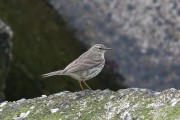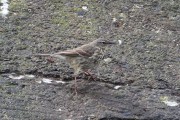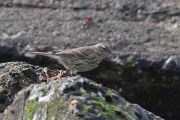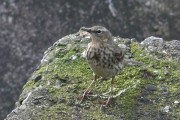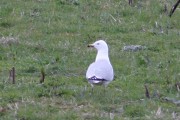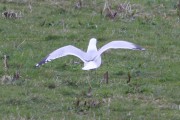Scandinavians and Americans
Posted by Roger Riddington on Tuesday 20th April 2010 | Birding in Shetland
In the early part of the Shetland spring, Rock Pipits are always worth a closer look. Perhaps surprisingly, Scandinavian Rock Pipits (a different subspecies from the ones that breed in Britain) are relatively rarely recorded in Shetland, and claims are still assessed by the local rarities committee. However, this may well be a function of the fact that the two races are so similar that many cannot be separated reliably. Happily, a few birds are distinctive, and this one, photographed at Scord, near Sumburgh, on 15th April is one of those.
The key features of this one that distinguish it from the local breeders include: the predominantly grey tones to the upperparts, in a particular a strikingly grey head, with little or no streaking; the striking whitish supercilium, broad and well-marked behind the eye; and the rather clean underparts, with a lack of yellow or buff tones to the ground colour but, more importantly, an obvious orangey-pink wash to the lower throat and upper breast. The pink wash in particular is a good feature since British birds rarely, if ever, show an obvious pink flush like this. The lack of the typical deep, saturated olive or yellow tones of a fresh-plumaged British bird are striking – although note that by April, many birds are heavily worn, as this bird is, and this may contribute to a duller, greyer appearance. (Many British birds and at least some Scandinavians appear not to have a pre-breeding moult at all, so their feathers are unchanged from the main, complete, moult carried out after the breeding season). This bird shows very worn wing feathers for example, and little in the way of wingbars. Notwithstanding, the combination of grey head and striking supercilia would not disgrace many summer-plumaged Water Pipits – although the heavy streaking on the underparts is a quick reminder that it is not a Water Pipit. Birders in Shetland are still waiting to find the first Water Pipit for the islands!
Surprisingly, 15th April was set to get even better in a birding context. After work that day, the cold north-westerly didn’t encourage me to get out on foot, birding from the car was much more appealing. Parked up overlooking Loch of Hillwell, there was no sign of any fresh migrants, but then a gull flying over the loch caught my eye. It was somehow ‘different’, but I couldn’t put my finger on it. Luckily, I managed to get my scope on it for a few seconds before it went out of view, and what stood out immediately was the well-defined black ring near the tip of the bill! I set off after it, hoping it was heading for a group or 100–200 gulls feeding in a newly ploughed rig. Happily, after few minutes I found it again; and it was indeed a Ring-billed Gull. This American species, closely related to our own Common Gull, is an annual visitor to Britain, but is more regular to the south of Shetland; there is fewer than 20 records in Shetland. At first, I assumed it must be an adult bird, given the distinctive bill pattern (the photos were taken after it had been digging in the newly turned earth, hence it appears to have an all-dark tip) and lack of any obvious sign of immaturity in the wings. However, after examining the photos, it seems more likely to have been a third-summer bird (in other words hatched in 2007), which would explain the dull leg colour, the rather extensive black in the wingtips, the noticeably small ‘mirror’ (white spot) on the outermost primary, and also some faint dark markings in the primary coverts. Anyway, it was a good bird to find, and this is probably the last of my bird-finding posts for this spring…


